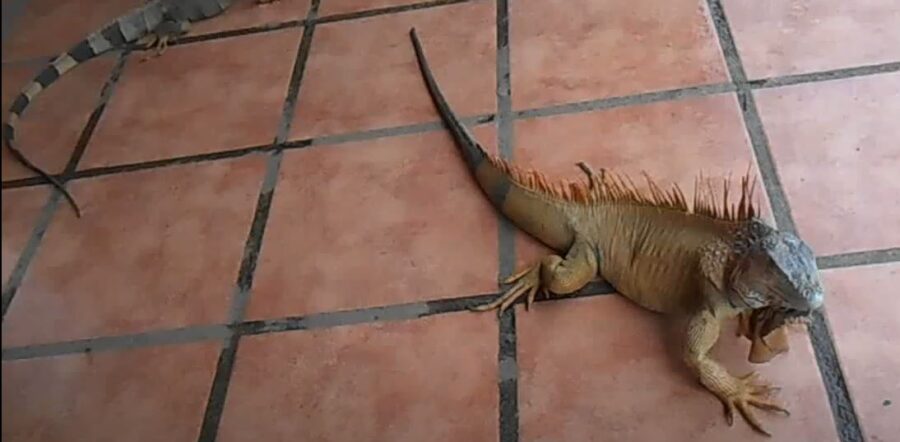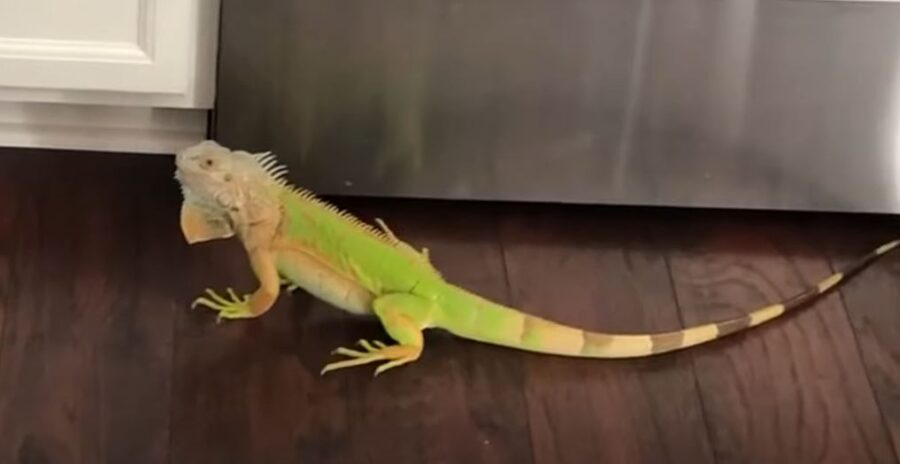As a young child, I wanted to pull the tail of my brother’s iguana to make it fall off. Thankfully, I never did and never will but does iguanas tails grow back?
Tail regeneration is a fascinating part of nature’s ability to allow some reptiles to live another day. A battle ensues or danger strikes and a tail is removed, pulled or lost, but the lizard survives.
In this article, we will see if we can include iguanas in this tail regenerating group and find out, does an iguana’s tail grow back?
Does Iguana Tails Grow Back?
Iguanas get chased by predators or must immediately flee danger in their habitat caused by forces of nature. Thankfully, they are able to survive without their tail when it partly or completely breaks off.
The experience they now undergo is autotomy as a defense and survival mechanism. The tail grows back! Be patient because it can take 2 months to a year depending on their age, habitat conditions and overall health.

How Often Will an Iguana’s Tail Grow Back?
You can expect your iguana’s tail to grow back, but you must factor in the following:
- Species
- Age
- Environment
- Health
Expect it to regenerate in 2-12 months for most cases. A tail can grow back as much as 12 times in the average life of an iguana in the wild.
A captive iguana may never experience the desperation around alarming events that allow them to ditch their tail and survive.
The regrowth of a tail could be anywhere from partial to a complete restoration and regeneration. There are cases of a single green juvenile iguana fully re-growing its tail 6 times in one year.
What To Do When an Iguana Breaks Tail
The tail is partially or completely broken and you’re looking flabbergasted at what you’re seeing. Don’t worry, this happens in the wild and now you are in charge.
What do you do? First of all, know that even if you see some blood loss, it is minimal and an artery has not been severed.
Here are some tips to assist:
- Apply styptic powder to stop the bleeding (if any).
- Use iodine to clean the wounded area.
- Apply a reptile solution like Betadine or its reptile equivalent sold in exotic pet shops.
- Look for signs of infection and shedding. (more on shedding here)
- Visit a vet for possible amputation of the partially remaining portion(s) of the tail (if any).
Do not expect the regeneration to take place immediately. Allow time and also realize that the new tail will not look exactly the same as it was before.
Be careful at this point when a vulnerable iguana may wish to bite. Please see this article to help explain what to do about biting iguanas.

How Do Iguanas Regrow Their Tail?
We watched and waited to see what would happen after our iguana accidentally lost his tail in an accident where it was tangled between two branches in his enclosure.
He struggled and released with a tug under his own will and force. He wanted to escape. The regeneration process involves a few steps after this point.
Tail Regeneration
Here are some steps that will follow:
- Your iguana will feel stress.
- They may need time alone.
- Provide hiding spaces after treating a possible wound with iodine.
- The wound healing phase involves wound closure.
- The broken end will partially disintegrate.
- Some muscles, bones and cartilage will change form down to their epithelial cells.
- Blastema phase follows with cell regeneration.
- The tail grows back in about 2-12 months, but never looks the same as before.
The tail might be slightly longer, more slender, or the cartilage and vertebrae may change shape slightly. The tails are all unique in their structure and form when examined closely.
Is My Iguana In Pain?
Does it hurt when an iguana loses their tail? Your iguana might be feeling discomfort or stress. This fracture occurred at a weak point in their physical makeup. It happens in an area called the “fracture plane”.
There is minimal blood loss and no threat of bleeding out or death from it. Rare occasions or secondary injuries may prove fatal, but a severed tail should not be life threatening on its own.
It’s hard to tell if every iguana is hurt or undergoing pain from losing its tail. We know that shock, stress and fear may result where they might need a few days on their own to process or return to their generally inquisitive or aware state.
At this point, continue filling their water, cleaning up and providing fresh meals. If they do not eat much, that’s ok for the first few days to a week.

Will My Iguana Live Without A Tail?
In most cases, an iguana will be able to regrow its tail. It may not be as long, wide or look exactly the same as before, but a tail can regenerate for iguanas. During the time they are functioning without their tail. They may lose their balance.
Our iguana was looking wobbly for a few weeks while he waited for his tail to grow back. We have also witnessed two iguanas in captivity at a local breeder’s where one was chasing the other violently.
He deduced that the aggressor was feeling “tail envy” because of jealousy that the other still had his tail while this iguana did not.
The bullying looked like the aggressor wanted to steal or snatch the tail off the innocent victim. They needed separation until the iguana with a lost tail started to notice that it was growing back .
How To Care For An Iguana With A Broken Tail
You can treat the wound with Betadine, Neosporin, iodine or spend a bit more at the exotic pet shop or vet clinic to purchase reptile ointment for this exact situation.
- Clean the enclosure carefully to prevent infection to the wound.
- Raise the temperature slightly to promote healing.
- Give them highly nutritious foods.
- Keep the surrounding area quiet and low traffic with less activity around your iguana.
Do not worry or become stressed from this occurrence. Respect nature’s way and admire the impressive ability for this beautiful creature to survive and live on with this wonderful adaptation.
For more on information on why iguanas attack each other and humans, please check out this article I wrote.
Thank you for visiting PocketPetCentral.com for the best information to help you enjoy the life of your pocket pet companion in a fun, safe & healthy way.


